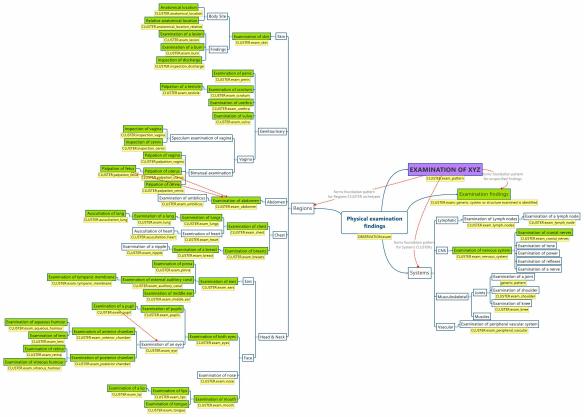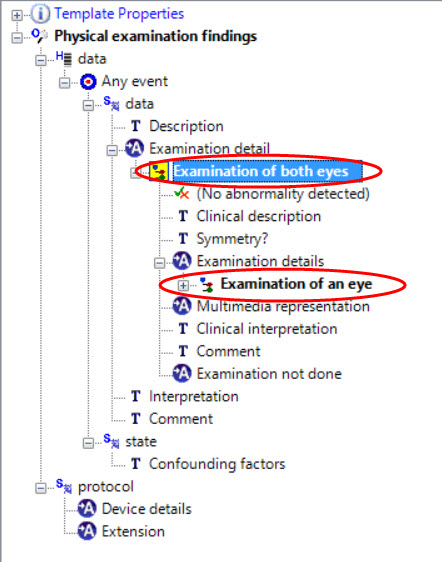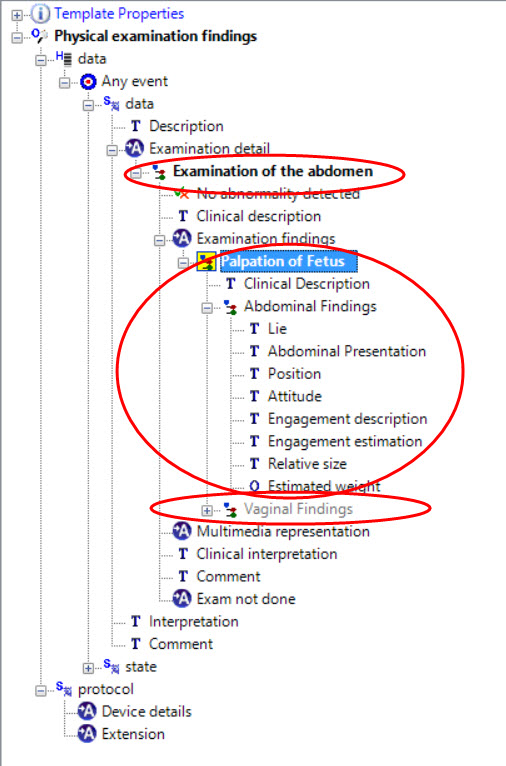In testing out the physical examination CLUSTER archetypes, the ones highlighted in green are currently present in the Examination Findings project on the openEHR CKM.

Most of them follow the pattern identified in the ‘Examination of XYZ’ archetype (CLUSTER.exam_xyz).
The majority of the archetypes developed so far follow this pattern, and each has been developed using the base pattern only. It is intended that the detail will be added when it is identified as requirements for real world implementations. Until the detailed requirements are identified, the base pattern will enable the simple data representations for each clinical concept to be represented consistently.
Clearly the mind map, above, does not represent all of the physical examination domain. The scope and diversity of clinical content in this physical examination domain will grow over time, and the concept-specific detail within each model will be added as backwardly compatible revisions of these archetypes. In this way they will evolve in an organic way to suit clinical requirements, but within a tightly governed environment.
There are a number of archetypes that have been identified that have some special requirements, in addition to the ‘Examination of XYZ’ archetype pattern. These include:
-
Examination of body sites that are bilateral
In this example the ‘Examination of both eyes’ archetype can nest the ‘Examination of an eye‘ archetype. This allows comparison of one eye to another, and this will be applicable for examination of any bilateral body site – ears, eyes, breasts, nipples etc. The ‘Examination of an eye’ archetype will then record findings that will need identification of the side being examined.

You might also notice that the ‘No abnormality detected’ data element has brackets around the name. This is because an additional run-time name constraint has been applied that will allow clinicians to express that the normal statement is PERL (or PERLA) – pupils are equal and reactive to light (and accomodation).
-
Examination of skin
Examination of the skin needs some adaptation. Firstly, we need to enable the exact bit of skin that is being identified – this could be precise in terms of an well known anatomical site, for example the cubital fossa of the right arm, or it could need to be described in more generic terms, for example 5cm proximal to the medial epicondyle of the right arm.
Secondly, we could need to examine a lesion or wound, both of which have their own characteristics that warrant their own archetype, or any other abnormality which we may need to describe from first principles, or an assessment of 5 keratoses being present in the region, plus one naevus. There are many other possible ways that a clinician may want to record skin exam findings. This adaption of the XYZ pattern is trying to provide a flexible pattern that allows for flexible recording.
-
Examination of the fetus in utero
A fetus in utero can be examined as part of an abdominal examination or as part of a vaginal examination during labour.
In this first example above, the Palpation of the fetus’ archetype is inserted into the ‘Examination of the abdomen’ archetype. Note that the cluster for ‘Vaginal findings’ is greyed out as not active for this particular clinical scenario.
And in this second example, the ‘Palpation of the Fetus’ archetype is inserted into the ‘Palpation of the Cervix’ archetype – ensuring that the recording of the fetal findings on examination are kept with the context of a vaginal examination. In this example, the ‘Abdominal findings’ cluster has been made inactive and the ‘Vaginal findings’ cluster will be used instead.






